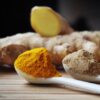So we have been sharing lots of chocolate recipes ideas with Valentines Day this month. However there is a side to chocolate and refined sugar in general that we need to address, sometimes our love of the sweeter things in life is causing us harm.
There has been more debate on sugar and its health impacts than any other food or food trend, we have even heard sugar addiction compared to opiate drug addiction! Back in the 1890’s sugar consumption was about 2.3 kgs per person per year, today it ranges up to 65kgs a year depending on the statistics you look at. Sugar cravings and high sugar intake are associated with hyperactivity, depression, moodiness and ADHD.
Sugar cravings are an indication of a physiological dysfunction and so our aim is to identify and resolve the cause of these cravings. Chromium is often used to regulate blood sugar levels, however this is rarely enough. Sugar cravings suggest dysbiosis, and so the introduction of powerful lactofermented foods can effectively reduce sugar cravings and develop the palette.
Today its difficult to avoid sugar…
Sugar hides in packaged and processed foods, some mayonnaise has more sugar than coke, balsamic vinegar, tomato and barbecue sauce have exceedingly high levels. Pre-marinated foods such as honey soy and teriyaki have high levels, and store bought juices can contain as much sugar as soft drinks.
Our children
The recommended daily amount of natural sugar is 3 – 5 teaspoons. This isn’t much and its easy to see how we exceed this amount easily with packaged and convenience foods.
Some tips we encourage:-
- Normalise healthy eating, don’t keep packaged food in the pantry and use healthy food choices as rewards if you choose to reward with food.
- Expose children to health talk, avoid ‘weight’ talk or ‘diet’ talk. Our bodies are amazing and can do lots of amazing things, celebrating this is important for creating a healthy culture around food choices.
- Try and try again, it may take a while for our little ones to eat their veggies, but exposure, gentle encouragement and fun games can work over time. Developing the taste palette to adjust to different tastes – salty, bitter, sour – takes time but you will be rewarded with strong healthy children in the long run!
- Swapping refined sugar for natural alternatives, such as rice malt syrup, maple syrup, stevia or raw honey. Also coconut sugar and rapadura sugar are nice alternatives.
How to kerb sugar cravings
- Using meal times to fill your plate with healthy fats and protein is important for staying full, eating well stabilises blood sugar levels and keeps us feeling balanced and focused.
- Small regular meals will also work to stabalise blood sugar levels
- Being organised with foods choices, menu plans and having healthy food choices in your line of sight in the pantry and fridge helps when you are in a rush.
- Avoid adding sugar to foods
- Look at the glycaemic index of foods – low glycaemic load diets will help with blood sugar regulation, the body ecology diet and GAPS diet aims to correct dysbiosis
- Consider the whole food principles – proteins and non-starchy vegetables, grains such as millet, quinoa, buckwheat and amaranth, legumes (if tolerated) and a limited amount of fruit. Working with your nutritionist to correct the diet one step at a time is essential to managing healthy lifestyle changes for the whole family.
If you suffer from sugar cravings and associated risks with a high sugar diet, we are trained to address the imbalances that occur within the body and can assist to having you back on track in no time.





